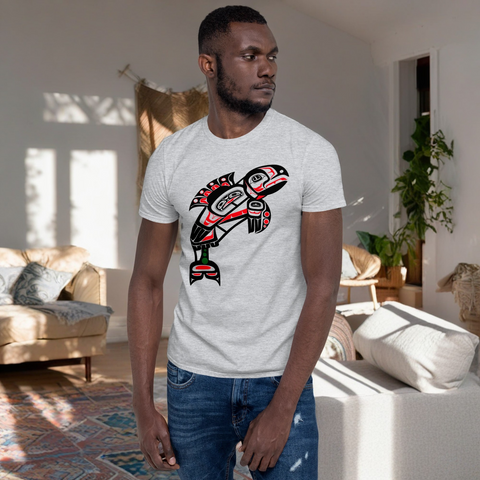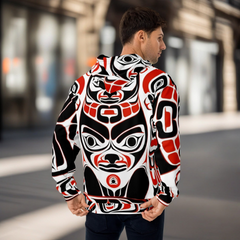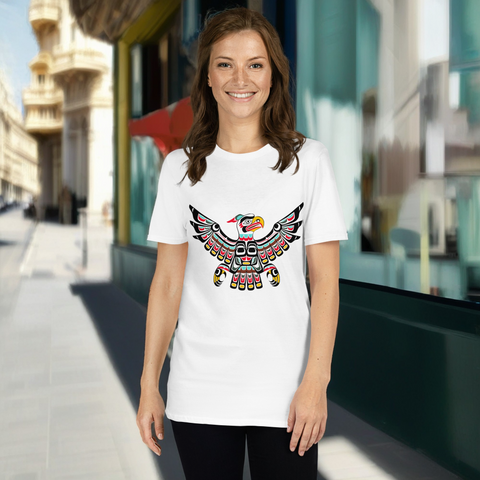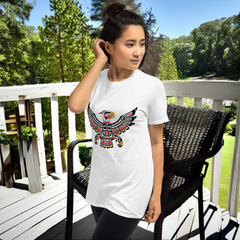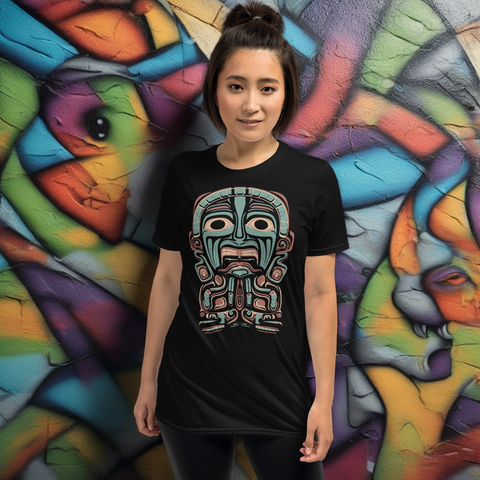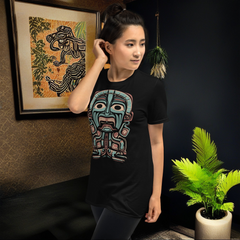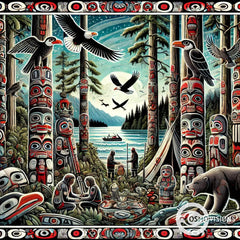Tlingit Symbols And Meanings: Unveiling The Crests And Emblems Of Alaska's First Nations
Posted by Massimiliano Geraci
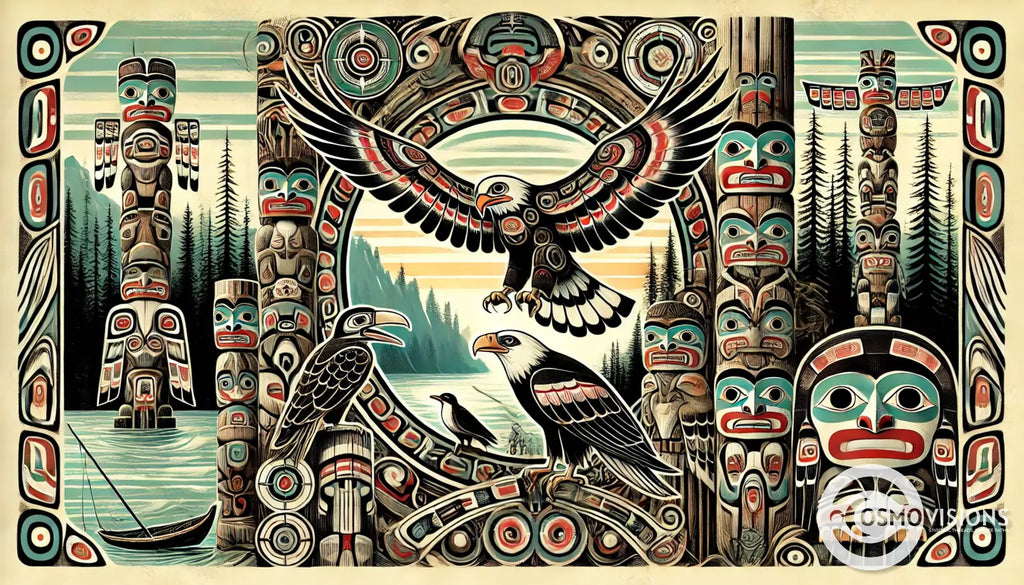
Many people are curious about Alaska's First Nations' rich symbols and emblems but find it hard to understand their deep meanings. The Tlingit tribe, with its unique culture and art, often featuring mythological creatures, remains a mystery to outsiders.
Interestingly, the Tlingit society is divided into two main groups, each represented by powerful natural symbols: the eagle and the raven.
This article will light your way through the forest of Tlingit symbols, explaining how these emblems shape clan identities, tell stories of ancient traditions, and highlight the spiritual connection between people and nature.
By exploring crests, totem poles, ceremonial regalia, and more, you’ll grasp what makes Tlingit culture so special.
Ready to explore?
Key Takeaways
-
Tlingit culture is deeply connected to nature, with the eagle and raven playing significant roles as symbols of clan identity. These animals represent traits like leadership, strength, creation, and knowledge.
-
Totem poles are not just art; they are stories carved in cedar that link the Tlingit people to their ancestors, history, and the natural world. Each figure on a pole tells a piece of a clan's story or embodies spiritual beliefs.
-
Potlatch ceremonies strengthen community bonds among the Tlingit by allowing clans to celebrate important events, exchange gifts, and honor their history through traditional dances and showcasing native art.
-
Modern Tlingits continue to revive and maintain their rich traditions through crafting totem poles and engaging in ceremonial practices such as potlatches. This strongly connects past generations' values and today's efforts to keep those traditions alive.
-
Emblematic objects like the Whale Hat signify status within the tribe and serve as vessels for honoring ancestors. Conflicts over these emblems highlight their deep significance within Tlingit society.
Understanding the Core of Tlingit Culture: Symbols and Their Meanings
The Tlingit tribe, a group shrouded in mystery among Alaska’s First Nations, weaves its history and beliefs into powerful symbols. Totem poles stand tall, telling stories of clans and embodying the essence of animals like eagles and ravens.
These emblems serve as more than art; they are the voice of the people, capturing tales from the beginning of time. The struggle for control over national emblems, especially the revered Raven, highlights their deep cultural significance.
Certain symbols and emblems are also associated with great wealth in Tlingit culture, signifying prosperity and status within the community.
Ceremonial hats and staffs carry greatness and endurance through generations. Each piece tells a story, marked by colors and materials selected with purpose. Such objects link today’s Tlingit to their ancestors, bestowing upon them identity and honor. Symbols bridge the past to present in Tlingit culture, carrying wisdom whispered through centuries. Next up is an exploration into how creatures like eagles represent leadership while frogs symbolize healing within this rich tapestry of Northwest coast tradition.
The significance of the totem pole in Tlingit society
Totem poles hold deep meaning in Tlingit society, embodying the rich tradition of symbols and crests representing clans, lineages, and stories. Artists carve these monumental sculptures from large trees like cedar, revealing narratives and values important to their community. Tlingit woodworkers use hot stones to burn designs into the wood before carving totem poles.
Each figure etched into a pole represents a cherished part of Tlingit lore — animals like the eagle or raven might signify clan identity. In contrast, other figures could narrate historical events or embody spiritual beliefs.
These towering works are more than art; they assert identity, communicate status, and link individuals to their ancestors and the natural world. Totem poles are central in ceremonies where communities gather to honor their heritage.
Through this practice, the Tlingit maintain strong family ties and ensure that their history and culture continue across generations.

How animals like the eagle and raven symbolize Tlingit clans
In Tlingit culture, clans identify closely with either the eagle or the raven, serving as symbols of their clan’s identity and values. The division into two great bodies, the Tlhigh-naedi and Shungoo-kaedi, frames this connection deeply within their societal structure.
Each clan within these bodies adopts an animal emblem that guides them in embodying specific traits and histories. For instance, the Eagle clans draw from qualities of leadership and strength inspired by the majestic bird soaring through southeast Alaska’s skies.
The grizzly bear is another powerful symbol representing power and endurance in Tlingit culture.
The Raven carries a special place in Tlingit heart; it symbolizes creation and knowledge. This enigmatic bird’s tale weaves through tribal history like threads in a rich tapestry.
Legends recall how disputes over the rights to use certain emblems, such as the conflict between Chilkat’s Ganah-said and Sitka’s Tluknah-adi over the Raven emblem, lasted decades but eventually enriched communal bonds among different groups.
These stories are not just past recounts; they live on today at potlatch gatherings where members honor their ancestors’ achievements under these crests painted on carved wooden poles or sewn onto ceremonial regalia.
Exploring the connection between Tlingit crests and clan identity
Tlingit crests serve as a powerful symbol of identity and lineage within the clan structure. These symbols, often depicted on totem poles and regalia, tell stories that have been passed down through generations.
Each crest is more than just an emblem; it represents the history, rights, and privileges that a family holds within the community. For instance, if a clan displays the eagle or raven on their pole or clothing, it signifies their connection to certain animal spirits and marks their place in the social order of Tlingit society.
Crests are not merely designs. They embody our ancestors' encounters with animals and other beings of this land.
These unique identifiers enable members to connect with each other and with other clans. By wearing or displaying these crests during ceremonies like potlatches—a vital event for gift-giving, storytelling, and asserting status among the Tlingits—individuals honor their ancestors and reinforce their role in both past narratives and future legacies.
This tradition ensures that Tlingit identity remains vibrant and deeply interwoven with the spiritual essence of nature's creatures such as bears, whales, frogs—the list goes on—each carrying its own distinct message about life's principles according to Tlingit thought.
The Eagle and the Raven: Deciphering Tlingit Moieties and Totems
The Eagle and the Raven hold deep meaning in the spiritual and social lives of the Tlingit people. These two birds divide Tlingit society into halves, known as moieties. The Eagle moiety embodies leadership and strength.
The double-headed sea serpent, a mythological creature representing duality and protection in Tlingit culture, also plays a significant role in their beliefs.
People under this emblem share a bond stronger than those outside their group. The Raven, on the other hand, stands for creation and knowledge. Its followers value cleverness and wisdom above all.
Throughout southeastern Alaska, totem poles rise high, telling stories of these clans’ origins and victories. They are not just pieces of wood but historical records carved by skilled hands.
A struggle over the right to use the Raven symbol shows its significance; it lasted thirty years between rival groups until settled peacefully with Youwok’s quest for the exclusive right to use the Eagle emblem among his people marking a pivotal moment in their history.
The role of moieties in Tlingit culture: Eagle vs. Raven
In Tlingit culture, society splits into two great bodies—Tlhigh-naedi and Shungoo-kaedi. These bodies form the backbone of their community structure, each housing distinct clans.
Within this social framework, moieties play a crucial part in defining identities and relationships. Eagle and Raven symbolize these divisions, guiding members in both personal and communal contexts.

Eagles represent one faction, while Ravens symbolize the other.
A historical battle underscores the importance of these emblems—a thirty-year dispute between the Ganah-taedi of Chilkat and the Tluknah-adi of Sitica over who had rightful claim to the Raven emblem highlights its significance.
Meanwhile, elders from Chilkats narrate how peace established possession of the Eagle symbol among their ranks without conflict with neighboring tribes like Tsimsian's Taequdi. Using crests that feature animals like eagles or ravens ties a person to their moiety and weaves together stories of alliances, territories, and ancient agreements that continue to influence Tlingit life today.
Animal symbolism: What do the eagle and raven represent?
The eagle, a majestic bird soaring the skies of Alaska, symbolizes power, knowledge, and prestige among the Tlingit people. It also stands for friendship and peace. The eagle’s ability to fly high above the earth represents leadership and strength in guiding the community.
With its dark feathers and sharp intelligence, the raven symbolizes wisdom, transformation, and creation. This bird is a key figure in stories where it brings light into the world.
Both these birds reflect important values and connect deeply with clan identities within Tlingit culture.
The sea lion, symbolizing endurance, is another significant animal in Tlingit mythology. Alongside it are the whale, frog, eagle, grizzly bear, and wolf, each representing different attributes and clans.
Eagles and ravens are divided into moieties or halves of society – each person belongs either to an Eagle or a Raven clan. This division is crucial in maintaining balance and harmony within communities throughout coastal areas like British Columbia and northern parts of Southeast Alaska.
These animals are carved onto cedar wood totem poles along with other symbols such as whales, bears, and salmon which tell stories about family lineage histories while strengthening kinship bonds among members.
-Totem poles: Telling stories of Tlingit clans and histories
Totem poles stand as mighty storytellers of the Tlingit people, each carving weaving together the tales of clans and their histories. Crafted from towering cedar trunks, these grand structures serve as art and as keepers of lore and lineage.
Skilled carvers etch out figures of eagles, ravens, bears, beavers, and more, each symbolizing different facets of clan identity and spiritual beliefs. These animals speak volumes about the traits valued by the Tlingit: strength from the bear; wisdom from the raven; leadership qualities mirrored in the eagle.
These poles also record significant events - battles won, agreements forged between clans or marks of respect to influential ancestors. One pole might tell a saga like that of the Chilkat's struggle with Sitka’s over who rightfully owned the emblematic Raven or recount how ancestors established this revered national emblem through tales passed down generations.
It's a dynamic form of history-keeping alive in wood rather than written word.
Moving beyond mere symbols on wood to symbols in life would help us better understand how these crests embody living connections among members within Tlingit communities.
Emblems of Power: Tlingit Crest Objects and Their Ceremonial Uses
Moving from the stories carved into totem poles, Tlingit crest objects also hold a deep significance within their culture. These emblematic items, ranging from hats to staffs, are more than just ornamental.
The influence of Haida culture on Tlingit art and ceremonial practices is evident, particularly in educational programs and workshops that teach both Haida and Tlingit techniques.
They carry the weight of history and identity for the Tlingit clans. A notable example is the Whale Hat, expertly crafted from spruce tree roots by high-ranking members of the leading clan of the Tlhigh-naedi moiety.
This hat stands as a symbol of greatness and authority within the community.
Crest objects serve as markers of social status and vessels for honoring ancestors and connecting with spiritual entities. The struggle over emblems such as the Raven reflects deep-rooted values and stories passed down through generations.
For instance, this conflict between Chilkat’s Ganah-taedi and Sitka’s Tluknah-adi about who truly owns this national symbol lasted three decades. The legend of the Eagle emblem speaks volumes about peace over possession.

The meaning behind Tlingit ceremonial regalia
Tlingit ceremonial regalia holds deep stories, connecting wearers to their ancestors, land, and the animals around them. Each piece, whether it's a woven robe or carved mask, tells of battles won, alliances formed, and respect for nature's power.
Eagles and ravens appear prominently in these items, embodying leadership and creation myths that have shaped Tlingit society for centuries. Crafted from materials like cedar bark and adorned with symbols of the whale or bear, this regalia is more than clothing; it is a living narrative.
Artisans carve these sacred objects with immense skill and dedication, embedding each crest object - be it a staff or headpiece - with layers of meaning. The eagle emblem speaks to one’s role within the clan while the raven symbol allies its wearer with knowledge passed down through generations.
Through colors vibrant as Alaska’s northern lights and patterns as intricate as its coastlines, Tlingit ceremonial attire connects community members across time. Wearing them during potlatches reinforces bonds between clansmen by honoring their shared histories and culture deeply rooted in the archipelago of northwestern America.
How crests bestow identity and honor among the Tlingit
Moving from the intricate designs of Tlingit ceremonial regalia, crests emerge as profound symbols that bestow both identity and honor within the community. Crests, embodying figures such as the eagle, raven, or killer whale, are vital identifiers.
They link individuals to their clan's history, asserting their place and role within the broader tapestry of Tlingit culture. Through these emblems passed down across generations, members wear their lineage and achievements with pride.
Crests also play a crucial part in ceremonies like potlatches, reinforcing social bonds and communal continuity. Wearing or displaying a crest communicates one’s status within the clan and across Tlingit society at large.
This tradition ensures that even today, these symbols remain a living testament to each clan’s unique heritage and its enduring connection to both land and sea. They reinforce ties among the present generation and link them back to their ancestors' stories engraved in cedar through exquisitely carved totem poles.
Tlingit art: Carving and painting as a form of Northwest Coast art expression
Crests give the Tlingit their identity and honor. Similarly, Tlingit art uses carving and painting to express these emblems in a visual language. Artists from the Pacific Northwest Coast create intricate designs on wooden totem poles, ceremonial regalia, and more.
Each piece tells a story of clan history, spirituality, or nature's power through symbols like the eagle or raven.
Ownership of emblematic objects led to warfare between clans.
Carvers bring legends to life in cedar wood, while painters use bold colors on canvas and wood. The Whale Hat, woven from spruce tree roots by skilled artisans for the leading clan of the Tlhigh-naedi moiety, showcases this artistic mastery.
These creations are not just art; they are a vital part of Tlingit culture and heritage that connect past generations with today's communities along Alaska's coastlines.
The Spiritual Essence of Tlingit Totem Poles
Totem poles are towering testaments to the Tlingit people's spiritual connections and ancestral heritage. Craftsmen carve these monuments from cedar, etching into their surface stories of spiritual beings, animals, and mythic figures that resonate deeply with the Tlingit worldview.
Each figure on the pole holds a story or lesson, making these more than just art; they are carriers of wisdom passed down through generations. The process itself is sacred, linking today's carvers with those who came before them and ensuring continuity in this profound practice.
The revival of totem pole creation speaks volumes about its importance in modern Tlingit culture. As new poles rise along Alaska's panhandle or within cultural institutions like the Sealaska Heritage Institute, they reaffirm connections to nature, community, and ancestry.
These creations do not merely decorate the landscape; they embody the living spirit of Tlingit values and beliefs. With every chiseled detail comes a dialogue between past and present—a lasting legacy carved in wood for all to see.
Interpreting the spiritual messages encoded in totem poles
Carvers shape totem poles from cedar, a wood chosen for its endurance and spiritual qualities. Each figure on the pole tells part of a story or symbolizes an emblem important to the clan.
For example, the raven signifies creation and knowledge, reflecting Tlingit myths and social values. The eagle represents leadership and strength. When these animals appear on a pole, they speak of clan identity and ancestral tales.
Crafting a totem pole involves more than skill; it requires understanding nature's rhythms and Tlingit spiritual beliefs. Totem creators weave together stories of alliances, such as between the Raven and Eagle clans, showing respect for their shared history.
Through these carvings, artists maintain a bond with ancestors and express commitments to future generations.
Next, we explore how techniques of carving cedar have evolved over time while retaining deep spiritual connections.
The craftsmanship of cedar: Techniques of totem pole carving
Moving from the spiritual essence that guides the creation of totem poles, we explore how these magnificent structures take shape. Totem pole carvers transform cedar into powerful symbols of Tlingit culture, using age-old techniques passed down through generations.
They carefully select the right trees, often choosing those over a century old for their quality and size. The process involves chiseling away at the wood, gradually revealing figures representing animals, ancestral stories, and clan identities.
These artisans use traditional tools like adzes—a type of ax—and curved knives to carve intricate details into cedar logs. Cedar is favored for its resistance to rot and insects, making it ideal for outdoor poles that withstand harsh northern climates.
Throughout Alaska's coastlines and forests, where cedar grows abundantly, skilled craftsmen turn these materials into storytellers. Each stroke adds depth to the wood and the rich tapestry of native culture and tradition Tlingit communities cherish deeply.
The revival of totem pole creation in modern Tlingit culture
Mastering the techniques of carving cedar has paved the way for a significant movement in Tlingit culture. Today, the Tlingit tribe is actively reviving totem pole creation as a vital expression linking their past with the present and future.
This revival is not just about preserving an art form but also about keeping alive the stories, beliefs, and traditions of the Tlingit people for future generations.
Modern Tlingit artists are at the forefront of this cultural resurgence, crafting totem poles that serve both as reminders of historical events and as symbols of clan identities within Alaska's first nations.
Through these towering works of art, they tell tales of animals like eagles and ravens—central figures in Tlingit mythology—and illustrate important societal values. With each stroke and carve, these artists ensure that key aspects of their heritage remain vibrant and relevant in today's world.
Totem poles are our bridge between worlds: honoring our ancestors while guiding future generations.
Potlatch: The Heart of Tlingit Social and Cultural Exchange
Potlatch ceremonies are the core of Tlingit and Haida communities’ social bonds. Clans gather to celebrate their history and achievements and honor their ancestors. These gatherings are crucial, for they maintain social ties and reinforce the community’s structure.
Traditional foods such as fish, seafood, and wild game play a significant role in potlatch feasts, reflecting the Tlingit clan's culinary practices and sustenance methods.
Clans display their wealth and generosity by exchanging gifts and hosting grand feasts. They spotlight artistic skills with traditional dance performances, vital in cultural exchanges within these coastal communities.
The tradition of Potlatch allows the Tlingit people to forge stronger alliances, resolve conflicts, and pay tribute to forebears through various rituals. This celebration is a vibrant expression of art and culture that includes showcasing large collections of native art, such as carvings on cedar or spruce wood used in creating ceremonial regalia like hats and staffs.
These artifacts often feature prominently symbols from nature—eagles for leadership, ravens for creation—highlighting the important roles clan members play within this intricate societal web along Alaska’s panhandle.
The significance of potlatch in Tlingit and Haida communities
Potlatch ceremonies are central to Tlingit and Haida cultures, marking a complex system of social and spiritual exchange. These ceremonial gatherings celebrate pivotal moments such as births, deaths, and marriages.
Competition flourished among the Kwagiulth with these ceremonials, especially as populations dwindled. Leaders would distribute vast amounts of wealth at potlatches to solidify their status within their tribes.
This practice allowed individuals to claim and maintain high positions in society.
This tradition deeply intertwines with the spiritual life of communities along the coast of Alaska and northern British Columbia. Through potlatch, Tlingit and Haida peoples weave a rich tapestry of community bonds and cultural identity.
Gifts like intricately woven blankets or carved wooden items are more than mere objects; they are imbued with significant meanings and histories. Members affirm their place within the clan's lineage by participating in these exchanges, honoring ancestors while ensuring their customs thrive into future generations.
Gift-giving and social status in the potlatch ceremony
In the potlatch ceremony, chiefs and community leaders showcase their wealth and status by giving lavish gifts to attendees. This act of generosity strengthens bonds within the tribe and cements the giver's high standing.
Gifts range from handcrafted items to precious resources, each symbolizing the host’s prosperity and benevolence. During these ceremonies, participants wear traditional regalia that represents their clan symbols, such as the eagle or raven, weaving a rich tapestry of Tlingit culture and heritage.
The more magnificent the gift, the greater respect and honor afforded to the giver.
This tradition redistributes wealth among members and serves as a platform for announcing significant life events — births, marriages, or remembrances of ancestors. Through these exchanges, social hierarchies are affirmed and redefined in front of a communal audience.
As competitive potlatches gain prevalence with declining native populations, individuals invest heavily in these celebrations to assert their stature within tribal society effectively.
This dynamic interplay between gift-giving and social ranking underscores a vital aspect of Tlingit cultural identity.
Modern expressions of the traditional Tlingit potlatch1. Introduction
Transitioning from the deep-rooted significance of gift-giving and social stratification in traditional Tlingit potlatch ceremonies, we observe how these practices have transformed in today’s society.
The modern expressions of potlatch showcase a blend of endurance and evolution within Tlingit culture, embracing both ancient traditions and contemporary needs.
Today's Tlingit communities continue to honor their cultural heritage through potlatch ceremonies. These events still serve as vital platforms for affirming clan identities, handing down stories, and upholding the community's social fabric.
While the core values remain intact, modifications are evident to accommodate current lifestyles. For instance, while ceremonial regalia like hats symbolizing power may no longer lead to disputes that could escalate into serious warfare among clans, they are proudly worn to signify one's place within the intricate hierarchy of Tlingit society.
Similarly, crests—once a source of intense rivalry for ownership over emblematic objects like the revered Raven—are now more commonly shared in celebrations that strengthen communal ties rather than divide.
Such gatherings weave together threads from an anthropological tapestry rich with symbols like eagles representing leadership and ravens signifying creation but also adapt storytelling methods that resonate with younger generations.
This ensures that the cultural narrative remains vibrant amidst changing times. Carvings on cedar become not just relics of past craftsmanship but living testimonies to a culture continually finding new ways to express its identity, spirituality, and connection to nature across Alaska’s landscapes—from glacier-carved valleys to dense woodlands housing bears and thunderbirds alike.
Understanding Tlingit Symbols
Explore Tlingit culture by discovering the symbols that bind their world together, from towering totem poles that reach towards the sky to intricate crests that tell tales of kinship and identity.
The Tlingit language plays a crucial role in preserving the meanings and stories behind these symbols, with its complex grammar and unique sound system. Efforts by linguistic anthropologists to record the language for future generations are vital due to its limited number of fluent speakers.
Significance in Tlingit Culture
Clans and emblems play a crucial role in Tlingit culture. These symbols tell stories of ancestry, identity, and values passed through generations. The Eagle and the Raven become more than birds; they embody leadership, creation, and knowledge within two great bodies known as Tlhigh-naedi and Shungoo-kaedi.
These divisions shape the society into groups that identify themselves with specific living things. This connection is deep-rooted in ceremonies involving ceremonial hats and totem poles, which are large collections of stories carved in wood.
Crafting these emblematic objects involves much sacrifice. Disputes over their ownership have even led to warfare between clans like the Ganah-taedi of Chilkat and the Tluknah-adi of Sitka.
This struggle over the national emblem lasted for thirty years, highlighting how integral these symbols are to clan pride and heritage. Such conflicts underscore the significance attached to animal symbols like eagles or ravens among native people along Alaska's panhandle.
Next comes exploring how these crest objects function within rituals.
Role in Identity and Kinship
Symbols and crests in Tlingit culture are more than just art; they are vital markers of identity and kinship. Totems, such as the Whale Hat of the leading clan in the Tlhigh-naedi group, show greatness and a deep sense of belonging.
Clans divide into two main groups, Tlhigh-naedi and Shungoo-kaedi, with family lines tracing back through paternal descent. This system ensures that each totem or emblem directly ties an individual to their ancestors' histories.
Clans battled for ownership over the national symbol, the Raven, for thirty years. This struggle highlights how deeply these symbols connect members within the community.
Louis Shotridge's work in "The Museum Journal" sheds light on this complex network of emblems and their roles in weaving together clan identities—a task paramount for understanding Tlingit heritage at places like the American Museum of Natural History where large collections detail Northwest Coast art and culture.
Symbols like the eagle represent leadership while ravens stand for creation knowledge. Each carved piece on a totem pole tells part of a clan’s story, linking past generations with present members under common symbols.
Such artifacts are not mere objects but essential elements defining social status within clans—like hats showing historical events or staffs marking significant achievements—making them priceless pieces in cultural exhibitions across Alaska State museums dedicated to Native communities’ history.
Now let us turn our attention to key emblems like eagles and ravens that further delve into what these creatures embody within Tlingit lore.
Key Tlingit Emblems and Their Meanings
Explore the core of Tlingit culture by examining emblems such as the eagle, which stands for leadership and strength, and the raven that brings creation and knowledge to light. Discover how each symbol integrates deeply into the fabric of clan identity, offering a window into a rich tapestry of stories and values passed through generations.
The salmon, a favourite food, symbolizes prosperity and renewal in Tlingit culture.
Eagle: Leadership and Strength
The Eagle stands tall as a symbol of leadership, strength, and prestige in the rich tapestry of Tlingit culture. This majestic bird represents power and mirrors the community's values of friendship and peace.
To have the Eagle emblem within a clan is to hold high honor, signaling a group led by wisdom and courage. The Tlingit people showed their respect and desire for these qualities by bringing offerings to acquire this powerful symbol.
Holding an eagle crest speaks volumes about one's place in society - it marks individuals as leaders among community members. This tradition showcases how deeply animals and humans connect in Alaska's indigenous cultures, linking personal names with creatures that embody desired traits like strength from the grizzly or wit from the raven’s cunning mind.
The eagle, with its broad wingspan soaring above land and sea, serves as a guiding light for actions that foster unity and uphold traditions across generations within the Tlingit clans.
Raven: Creation and Knowledge
Raven plays a central role in Tlingit culture, embodying creation and knowledge. This bird is more than just a symbol; it represents the power to create and transform. For thirty years, Tlingit groups fought over who would hold the national emblem of Raven, showcasing its deep importance.
Ravens are not simple creatures but are seen as messengers between the spiritual world and our own.
This emblem teaches us about the universe's mysteries through stories passed down across generations. These narratives often explore how Raven brought light to humanity or found water when none existed.
Through such tales, community members learn valuable lessons about innovation, survival, and respect for nature that surrounds them. Carved on totem poles or woven into ceremonial regalia like hats and staffs, Raven's image continually reminds the Tlingit people of their connection to both past wisdom and future possibilities.
Frog: Persistence and Healing
Moving from the raven's domain of creation and knowledge, we focus on another crucial figure in Tlingit culture: the frog. This creature holds a special place as a symbol of persistence and healing.
Frogs are known for their resilience, adapting to both water and land environments. In Tlingit culture, they represent not just physical healing but emotional and spiritual renewal as well.
These amphibians embody innocence yet carry profound wisdom in their calls, which echo through the forests and waters of the Alaska Panhandle.
The frog also plays an essential role in communication among community members, bridging gaps with its distinctive sounds that resonate across vast distances. This ability highlights stability and good luck, vital elements for maintaining harmony within clans.
Through art forms like totem poles and ceremonial regalia found throughout many Native American communities, including those large collections housed at institutions like the National Museum of Natural History, frogs stand tall as guardians of health and perseverance amidst challenges.
Their presence on crests is a constant reminder of nature's cycles of rejuvenation—a core principle deeply ingrained in clan culture.
Bear: Power and Courage
The bear stands tall in Tlingit culture, embodying unmatched strength and bravery. Known for its significant presence in stories and totem poles, this creature commands respect across generations.
Its powerful symbolism extends beyond physical might, touching on leadership qualities revered by the Tlingit people. Bears are central figures on many symbolic objects like ceremonial chests and totems, where their images tell tales of valor and authority.
In crafting these emblems, artisans pour centuries of knowledge into each piece of wood or stroke of the paintbrush. The intricate detail captures not just the bear's raw power but also its spirit of guardianship and protection within the community.
This animal’s portrayal serves as a constant reminder of one’s duty to lead with courage, fortify bonds within clans, and honor the ancestral wisdom that keeps Tlingit traditions alive.
Through these expressions—be it carving or painting—the bear continues to inspire words and actions grounded in strength and dignity among Alaska's First Nations.
Crests and Totem Poles
Crests and totem poles are powerful symbols within Tlingit culture. They connect families to their ancient stories, showcasing honor and history.
Symbolism in Carvings
Totem poles are usually carved from cedar, a tree cherished by the Tlingit for its spiritual meaning and durability. These magnificent carvings stand as records of clan and culture, each figure representing an aspect of the community's identity or history.
For instance, an eagle on a totem pole symbolizes leadership and strength, while the bear is a symbol of power and courage. The artists imbue every chip in the wood with purpose. They turn animals like ravens, hummingbirds, orcas into guardians of their lore.
Through these figures, Tlingit carvers share stories passed down through generations.
Crafting these totems involves more than skilled hands; it requires a deep connection to the forest and spirit worlds. Carvers select trees for their physical qualities and place within Tlingit territory's spiritual landscape.
This choice reflects respect for nature that is central to Tilingit life. As such objects grow from raw cedar into towering emblems of familial heritage or mythical tales involving creatures like octopuses and frogs, they become emblems woven into social fabric itself—continuing traditions powerful enough to sustain disputes over emblem ownership at times leading clans towards warfare yet managing this heritage evokes community cohesion rather than division.
Connection to Tlingit History and Clan Histories
Tlingit symbols and emblems carry the stories and values of their clans through time. These marks connect each member to a large collection of Tlingit history, binding them to their ancestors and future generations.
By wearing or displaying these crests, a Tlingit person asserts their identity and honors their people's journey. The eagle and raven are not just birds; they emerge as guardians of lineage, narrating tales of hunting and fishing in territories that clans have called home for centuries.
Carvings on totem poles are visible records, immortalizing clan legends with every figure they bear. For instance, the beaver symbolizes community and protection while a butterfly may represent transformation within the clan narrative.
Such imagery showcases how deeply interconnected personal identities are within this vibrant cultural mosaic. As families gather at potlatch ceremonies equipped with hats sculpted from cedar or staffs adorned with ancestral emblems, these moments transcend simple gatherings—they become living museums where art meets oral tradition to keep Tlingit heritage alive.
Next comes an exploration into ceremonial artifacts unique to this rich culture.
The Role of Ceremonial Artifacts
In Tlingit culture, artifacts like ceremonial headdresses and walking sticks carry stories of ancestry and prestige. These items use colors, materials, and designs to show rank and history within the community.
Hats and Staffs: Symbols of Status and History
Tlingit ceremonial hats and staffs stand as powerful symbols of status, history, and cultural identity. Each hat, carved with immense detail and often featuring animals like the eagle or raven, tells a story of a clan’s lineage, victories, and connections to the spirit world.
The initiation process of a young man into Tlingit society often involved the use of ceremonial hats and staffs, which played a significant role in marking his transition and status within the community.
These objects were not merely decorative; they embodied the wearer’s rank within their community and their family’s accomplishments over generations. Making these pieces required skillful hands, a deep understanding of Tlingit lore, and access to precious materials that signified wealth and power.
Staffs served as another emblematic object within Tlingit society, often used alongside hats in ceremonies to represent authority or commemorate significant events. They could be adorned with symbols such as bears or frogs—each adding layers of meaning to the artifact’s story.
The use of such emblems goes beyond art; it cements social bonds within clans and marks important moments in personal histories. These items were so important that conflicts arose over ownership rights—the three-decade struggle for the national symbol between Chilkat’s Ganah-taedi clan and Sitka’s Tluknah-adi highlights this aspect vividly.
Through these battles for emblematic supremacy, one can trace the profound significance attached to these objects not just as tools but as keepers of tradition and honor among the Tlingit people.
The Importance of Colors and Materials
Colors and materials hold deep significance in Tlingit ceremonial artifacts, reflecting cultural values such as endurance and power. The use of wood for fine carving, fabric in apparel, and animal quills for embroidery showcases the tribe's dedication to craftsmanship.
These elements adorn and also tell stories of greatness and courage through their visual appeal. For example, ceremonial hats enriched with vibrant colors signify status within the community, embodying both the spirit of the wearer and the ancestral legends tied to them.
Ceremonial objects such as paddles from canoes highlight the importance placed on materials like cedar wood, chosen for its durability and its sacredness. The struggle over national emblems like the Raven underlines how symbols painted or carved into these items carry weighty meanings about identity in Tlingit society.
Likewise, adopting living creatures as totems—eagles for leadership and beavers symbolizing persistence—deeply integrates natural symbolism into Tlingit culture. Through every thread woven or line carved, a story of connection between nature, spirituality, and clan identity unfolds vividly before our eyes.
FAQs
1. What does the beaver symbol represent in Tlingit culture?
In Tlingit culture, the beaver, known for its dedication to building and mate-for-life loyalty, is a powerful emblem of creativity and perseverance. This creature's ability to transform its environment mirrors the community's values of hard work and commitment.
2. How is the butterfly significant among Alaska's First Nations?
The butterfly, with its delicate wings and transformative life cycle, is a symbol of change and hope in many stories told by Alaska’s First Nations. It represents rebirth and the endless possibilities that come with new beginnings.
Can you explain why some crests have a mythological creature's head in the middle?
Crests bearing a head in the middle signify wisdom and leadership among Tlingit tribes. This central figure embodies guidance, looking into the past for lessons learned and forward to wisely lead future generations.
4. What role do colors play in Tlingit symbols?
The colors in Tlingit emblems carry deep meanings—blue represents peace and serenity, red signifies strength and passion, and green denotes growth and harmony with nature. These colors enrich each symbol or crest with layers of meaning beyond their initial appearance.



